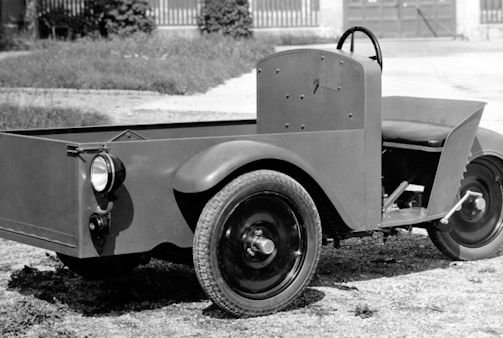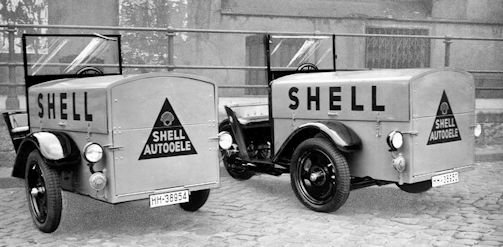BMW F 76 79
 |
|
|
Manufacturer: |
BMW |
|
Production period: |
1932 to 1934 |
|
Class: |
Commercial vehicle |
|
Body: |
various |
|
designs: |
truck 3 wheel |
|
Engines: |
Gasoline: 0.2-0.4 litres |
|
Power: |
4.4 - 8.8 kW |
The BMW F 76 was a small three wheel delivery van that BMW built from 1932 to 1933 in Eisenach . In 1933 this was updated to the BMW F 79 with a larger engine, which was manufactured until 1934.
History
With poor sales of expensive panel van version of the BMW 3/15 (with only 435 vehicles from May 1929 to February 1932) in the Great Depression and the simultaneous success of other manufacturers with three-wheeled trucks , BMW developed in Munich from 1931 a separate "muzzle loader" with two side-by-side seats using existing single-cylinder motorcycle engines. A one-seat variant was tested, but not included in the series ; as well as a version as a passenger car.
The BMW plant in Eisenach built from autumn 1932 F 76 for the license-free vehicle class with a maximum of 200 cc capacity at a retail price of 1,350 Reichsmarks. Already in January 1933 followed the F 79 with 400 cc capacity, which cost 1500 Reichsmark. The basic price contained only a horn and a speedometer. Windshield, windscreen wiper, cab, doors, electric winker, spare wheel, spare wheel holder and jack were additional; as well as all modified versions of the loading area. In front of the rear wheel driver and passenger sat on a car seat, under which the stationary single-cylinder engine was installed. Driver and passenger seats were to be provided at an extra cost with a closed cabin with 2 doors. A steering wheel was installed in front of the driver and a small platform (1,600 mm × 900 mm) was set up on the front axle. Under the bunk there was a transport box with front flap.
After only 600 copies (250 F 76 and 350 F 79 ), the construction of the vehicles, which actually came too late for the Great Depression, was discontinued in mid-1934 due to lack of customer interest.
As single-cylinder four-stroke engines with enclosed OHV cylinder heads, the engines largely corresponded to the motorcycle engines of the BMW R 2 and BMW R 4 , from which they were derived with minor modifications.
For engine cooling, there were at least two variants: a simple solution with V-belt, four-leaf fan in front of the cylinder, which was seen only in the test vehicles , and a more complex design with impeller on the front crankshaft stub and air baffles for cooling air flow, which also in manuals and spare parts lists. The rear wheel was driven via a three-speed gearbox with reverse gear and a cardan shaft .The tricycle had a powered rear wheel and two steerable front wheels. The rigid front axle was suspended by two leaf spring packs, which were installed longitudinally. At the rear wheel, BMW used a casted one- arm swinging arm , in whose longitudinal spar the cardan shaft ran. The foot brake pedal and the detectable handbrake lever acted on cables on all three drum brakes.
The complex design offered the following advantages:
- the rear wheel was easy to remove
- the disc wheels were interchangeable
- The joint disc of the double-ball bearing cardan shaft was located exactly in the axis of rotation of the rocker
- The bike guidance was very torsionally stiff
- The universal drive was maintenance-free and pollution-free every 10,000 kilometres compared to the usual chain drives except for the oil change

Technical
-
BMW F 76 79 Technical data (1932-1934)
F 76
engine
Single-cylinder four-stroke engine
bore
63 mm
stroke
64 mm
capacity
198 cm³
Performance
6 hp (4.4 kW ) at 3500 min -1
top speed
40 km / h
maximum weight allowed
650 kg
tank capacity
8 litres
F 79
engine
Single-cylinder four-stroke engine
bore
84 mm
stroke
78 mm
capacity
398 cc
Performance
12 hp (8.8 kW ) at 3500 min -1
top speed
60 km / h
maximum weight allowed
650 kg
tank capacity
8 litres
